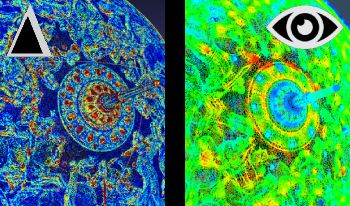
Selecting the optimal resolution and post-processing techniques of 3D objects for cultural heritage documentation is one of the most distinguishable challenges within 3D imaging. Many techniques exist to document a tangible object at very high objective accuracy, but there also exist techniques that can visualize a similar perceptual accuracy without documenting the objective values. The application difference between storage of complex geometric data and the visualization of it could be fundamentally different, and if the two methods are not disassociated it could lead to either false or inaccurate digital documentation of a cultural heritage object. In this investigation we compare several different metrics for evaluating the quality of a 3D object, both objectively and perceptually, and look at how the different approaches might report greatly different outputs based on the post-processing of a 3D object. We also provide some insight in how to interpret the output of various metrics, and how to compare them.

The No-reference Autoencoder VidEo (NAVE) metric is a video quality assessment model based on an autoencoder machine learning technique. The model uses an autoencoder to produce a set of features with a lower dimension and a higher descriptive capacity. NAVE has been shown to produce accurate quality predictions when tested with two video databases. As it is a common issue when dealing with models that rely on a nested non-linear structure, it is not clear at what level the content and the actual distortions are affecting the model’s predictions. In this paper, we analyze the NAVE model and test its capacity to distinguish quality monotonically for three isolated visual distortions: blocking artifacts, Gaussian blur, and white noise. With this goal, we create a dataset consisting of a set of short-length video sequences containing these distortions for ten very pronounced distortion levels. Then, we performed a subjective experiment to gather subjective quality scores for the degraded video sequences and tested the NAVE pre-trained model using these samples. Finally, we analyzed NAVE quality predictions for the set of distortions at different degradation levels with the goal of discovering the boundaries on which the model can perform.

In the last decades, many researchers have developed algorithms that estimate the quality of a visual content (videos or images). Among them, one recent trend is the use of texture descriptors. In this paper, we investigate the suitability of using Binarized Statistical Image Features (BSIF), the Local Configuration Pattern (LCP), the Complete Local Binary Pattern (CLBP), and the Local Phase Quantization (LPQ) descriptors to design a referenceless image quality assessment (RIQA) method. These descriptors have been successfully used in computer vision applications, but their use in image quality assessment has not yet been thoroughly investigated. With this goal, we use a framework that extracts the statistics of these descriptors and maps them into quality scores using a regression approach. Results show that many of the descriptors achieve a good accuracy performance, outperforming other state-of-the-art RIQA methods. The framework is simple and reliable.